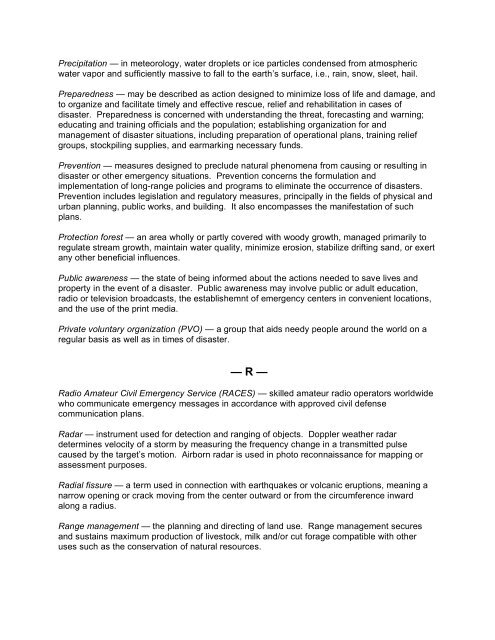Natural Hazards: Causes and Effects - Disaster Management Center ...
Natural Hazards: Causes and Effects - Disaster Management Center ...
Natural Hazards: Causes and Effects - Disaster Management Center ...
Create successful ePaper yourself
Turn your PDF publications into a flip-book with our unique Google optimized e-Paper software.
Precipitation — in meteorology, water droplets or ice particles condensed from atmospheric<br />
water vapor <strong>and</strong> sufficiently massive to fall to the earth’s surface, i.e., rain, snow, sleet, hail.<br />
Preparedness — may be described as action designed to minimize loss of life <strong>and</strong> damage, <strong>and</strong><br />
to organize <strong>and</strong> facilitate timely <strong>and</strong> effective rescue, relief <strong>and</strong> rehabilitation in cases of<br />
disaster. Preparedness is concerned with underst<strong>and</strong>ing the threat, forecasting <strong>and</strong> warning;<br />
educating <strong>and</strong> training officials <strong>and</strong> the population; establishing organization for <strong>and</strong><br />
management of disaster situations, including preparation of operational plans, training relief<br />
groups, stockpiling supplies, <strong>and</strong> earmarking necessary funds.<br />
Prevention — measures designed to preclude natural phenomena from causing or resulting in<br />
disaster or other emergency situations. Prevention concerns the formulation <strong>and</strong><br />
implementation of long-range policies <strong>and</strong> programs to eliminate the occurrence of disasters.<br />
Prevention includes legislation <strong>and</strong> regulatory measures, principally in the fields of physical <strong>and</strong><br />
urban planning, public works, <strong>and</strong> building. It also encompasses the manifestation of such<br />
plans.<br />
Protection forest — an area wholly or partly covered with woody growth, managed primarily to<br />
regulate stream growth, maintain water quality, minimize erosion, stabilize drifting s<strong>and</strong>, or exert<br />
any other beneficial influences.<br />
Public awareness — the state of being informed about the actions needed to save lives <strong>and</strong><br />
property in the event of a disaster. Public awareness may involve public or adult education,<br />
radio or television broadcasts, the establishemnt of emergency centers in convenient locations,<br />
<strong>and</strong> the use of the print media.<br />
Private voluntary organization (PVO) — a group that aids needy people around the world on a<br />
regular basis as well as in times of disaster.<br />
— R —<br />
Radio Amateur Civil Emergency Service (RACES) — skilled amateur radio operators worldwide<br />
who communicate emergency messages in accordance with approved civil defense<br />
communication plans.<br />
Radar — instrument used for detection <strong>and</strong> ranging of objects. Doppler weather radar<br />
determines velocity of a storm by measuring the frequency change in a transmitted pulse<br />
caused by the target’s motion. Airborn radar is used in photo reconnaissance for mapping or<br />
assessment purposes.<br />
Radial fissure — a term used in connection with earthquakes or volcanic eruptions, meaning a<br />
narrow opening or crack moving from the center outward or from the circumference inward<br />
along a radius.<br />
Range management — the planning <strong>and</strong> directing of l<strong>and</strong> use. Range management secures<br />
<strong>and</strong> sustains maximum production of livestock, milk <strong>and</strong>/or cut forage compatible with other<br />
uses such as the conservation of natural resources.








